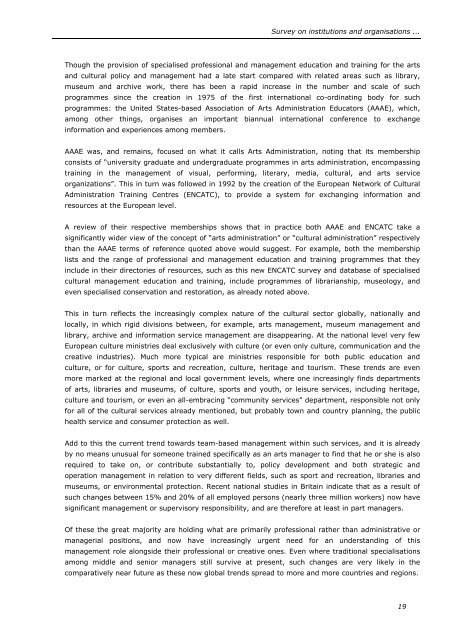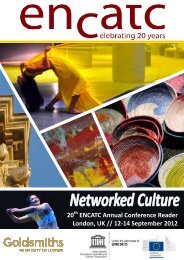Training in cultural policy and management: international ... - Encatc
Training in cultural policy and management: international ... - Encatc
Training in cultural policy and management: international ... - Encatc
Create successful ePaper yourself
Turn your PDF publications into a flip-book with our unique Google optimized e-Paper software.
Survey on <strong>in</strong>stitutions <strong>and</strong> organisations ...<br />
Though the provision of specialised professional <strong>and</strong> <strong>management</strong> education <strong>and</strong> tra<strong>in</strong><strong>in</strong>g for the arts<br />
<strong>and</strong> <strong>cultural</strong> <strong>policy</strong> <strong>and</strong> <strong>management</strong> had a late start compared with related areas such as library,<br />
museum <strong>and</strong> archive work, there has been a rapid <strong>in</strong>crease <strong>in</strong> the number <strong>and</strong> scale of such<br />
programmes s<strong>in</strong>ce the creation <strong>in</strong> 1975 of the first <strong>in</strong>ternational co-ord<strong>in</strong>at<strong>in</strong>g body for such<br />
programmes: the United States-based Association of Arts Adm<strong>in</strong>istration Educators (AAAE), which,<br />
among other th<strong>in</strong>gs, organises an important biannual<br />
<strong>in</strong>formation <strong>and</strong> experiences among members.<br />
<strong>in</strong>ternational conference to exchange<br />
AAAE was, <strong>and</strong> rema<strong>in</strong>s, focused on what it calls Arts Adm<strong>in</strong>istration, not<strong>in</strong>g that its membership<br />
consists of “university graduate <strong>and</strong> undergraduate programmes <strong>in</strong> arts adm<strong>in</strong>istration, encompass<strong>in</strong>g<br />
tra<strong>in</strong><strong>in</strong>g <strong>in</strong> the <strong>management</strong> of visual, perform<strong>in</strong>g, literary, media, <strong>cultural</strong>, <strong>and</strong> arts service<br />
organizations”. This <strong>in</strong> turn was followed <strong>in</strong> 1992 by the creation of the European Network of Cultural<br />
Adm<strong>in</strong>istration <strong>Tra<strong>in</strong><strong>in</strong>g</strong> Centres (ENCATC), to provide a system for exchang<strong>in</strong>g <strong>in</strong>formation <strong>and</strong><br />
resources at the European level.<br />
A review of their respective memberships shows that <strong>in</strong> practice both AAAE <strong>and</strong> ENCATC take a<br />
significantly wider view of the concept of “arts adm<strong>in</strong>istration” or “<strong>cultural</strong> adm<strong>in</strong>istration” respectively<br />
than the AAAE terms of reference quoted above would suggest. For example, both the membership<br />
lists <strong>and</strong> the range of professional <strong>and</strong> <strong>management</strong> education <strong>and</strong> tra<strong>in</strong><strong>in</strong>g programmes that they<br />
<strong>in</strong>clude <strong>in</strong> their directories of resources, such as this new ENCATC survey <strong>and</strong> database of specialised<br />
<strong>cultural</strong> <strong>management</strong> education <strong>and</strong> tra<strong>in</strong><strong>in</strong>g, <strong>in</strong>clude programmes of librarianship, museology, <strong>and</strong><br />
even specialised conservation <strong>and</strong> restoration, as already noted above.<br />
This <strong>in</strong> turn reflects the <strong>in</strong>creas<strong>in</strong>gly complex nature of the <strong>cultural</strong> sector globally, nationally <strong>and</strong><br />
locally, <strong>in</strong> which rigid divisions between, for example, arts <strong>management</strong>, museum <strong>management</strong> <strong>and</strong><br />
library, archive <strong>and</strong> <strong>in</strong>formation service <strong>management</strong> are disappear<strong>in</strong>g. At the national level very few<br />
European culture m<strong>in</strong>istries deal exclusively with culture (or even only culture, communication <strong>and</strong> the<br />
creative <strong>in</strong>dustries). Much more typical are m<strong>in</strong>istries responsible for both public education <strong>and</strong><br />
culture, or for culture, sports <strong>and</strong> recreation, culture, heritage <strong>and</strong> tourism. These trends are even<br />
more marked at the regional <strong>and</strong> local government levels, where one <strong>in</strong>creas<strong>in</strong>gly f<strong>in</strong>ds departments<br />
of arts, libraries <strong>and</strong> museums, of culture, sports <strong>and</strong> youth, or leisure services, <strong>in</strong>clud<strong>in</strong>g heritage,<br />
culture <strong>and</strong> tourism, or even an all-embrac<strong>in</strong>g “community services” department, responsible not only<br />
for all of the <strong>cultural</strong> services already mentioned, but probably town <strong>and</strong> country plann<strong>in</strong>g, the public<br />
health service <strong>and</strong> consumer protection as well.<br />
Add to this the current trend towards team-based <strong>management</strong> with<strong>in</strong> such services, <strong>and</strong> it is already<br />
by no means unusual for someone tra<strong>in</strong>ed specifically as an arts manager to f<strong>in</strong>d that he or she is also<br />
required to take on, or contribute substantially to, <strong>policy</strong> development <strong>and</strong> both strategic <strong>and</strong><br />
operation <strong>management</strong> <strong>in</strong> relation to very different fields, such as sport <strong>and</strong> recreation, libraries <strong>and</strong><br />
museums, or environmental protection. Recent national studies <strong>in</strong> Brita<strong>in</strong> <strong>in</strong>dicate that as a result of<br />
such changes between 15% <strong>and</strong> 20% of all employed persons (nearly three million workers) now have<br />
significant <strong>management</strong> or supervisory responsibility, <strong>and</strong> are therefore at least <strong>in</strong> part managers.<br />
Of these the great majority are hold<strong>in</strong>g what are primarily professional rather than adm<strong>in</strong>istrative or<br />
managerial positions, <strong>and</strong> now have <strong>in</strong>creas<strong>in</strong>gly urgent need for an underst<strong>and</strong><strong>in</strong>g of this<br />
<strong>management</strong> role alongside their professional or creative ones. Even where traditional specialisations<br />
among middle <strong>and</strong> senior managers still survive at present, such changes are very likely <strong>in</strong> the<br />
comparatively near future as these now global trends spread to more <strong>and</strong> more countries <strong>and</strong> regions.<br />
19






